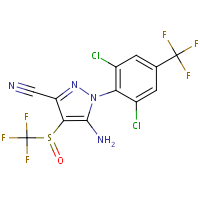Note from FAN: Fipronil is a highly toxic Acaracide, Insecticide and wood preservative. See adverse effects • some older abstracts • 2013 EU Conclusion on the peer review of risk to bees from Fipronil • PubMed abstracts on Fipronil toxicity. The molecular formula is

_____________________________________________________
Police are investigating after tests confirmed that poison was responsible for the death of hundreds of thousands of bees on a Murchison property in January.
Veteran beekeeper Ricki Leahy said bees from more than 300 hives on his and neighbouring properties had suffered and died over the course of several weeks.
Mr Leahy said tests had confirmed that the slow-working systemic insecticide – fipronil – was the source but it was unclear how it happened.
Police said they were working to establish if the poisoning of the hives on the Tasman District farm was malicious or not.
Mr Leahy said hives some distance from his farm were affected, but not as severely.
“The epicentre of the whole thing seemed to be just around this part of the Mangles Valley, but there’s evidence of sub-lethal effects 2.5 kilometres away.”
Mr Leahy estimated losses and costs to remedy the problem at several hundred thousand dollars. Beehives and associated infrastructure had to be destroyed or extensively sterilised, and diggers had to be brought in to help bury all the bees.
Mr Leahy said the emotional setback to his queen bee-rearing operation was greater than the financial loss, for which he had insurance.
“They actually carried on dying for two or three weeks, and hives we thought might survive have ended up succumbing to it.
“They [Ministry for Primary Industries] have now found out that the poison found in the samples of bees we sent away was fipronil.”
MPI said in January it was carrying out a suite of tests.
Spokesperson Lesley Patston said routine tests were being carried out for all common bee pests and diseases, and it was also looking at the possibility of “inadvertent poisoning with agricultural pesticides”.
‘They’re such fascinating little creatures’
Mr Leahy is also an ApiNZ board member and produces Tutaki Honey through his business Trees and Bees. He said the groundswell of support from around the country soon after the incident was revealed in January had helped counter the loss.
He had more than 45 years’ experience in the industry.
“I love beekeeping because it has such a small footprint on the environment, and the creatures are fundamental to the success of all agriculture though pollination.
“Bees are part of so many aspects of what’s happening in the countryside – they keep you aware of what’s flowering, the weather, the temperature.
“There’s always something to learn – it grips you always because they’re such fascinating little creatures.”
Mr Leahy said no more hives had been affected.
Fipronil in NZ
The Department of Conservation said the Environmental Protection Authority authorises use of fipronil in New Zealand.
It is used in a number of products, including Vespex bait, DOC uses to control common and German wasps on conservation land.
Vespex is a protein (meat-based) bait and does not attract bees, which prefer sugary food sources. The controls in place for its use also reduce the chance of exposure to bees or other non-targets.
DOC said the use of pesticides should be in accordance with the instructions on the product’s label. People mixing their own bait and not following instructions for correct use of toxins risk causing environmental damage.
*Original article online at https://www.radionz.co.nz/news/national/351648/murchison-bee-deaths-now-a-police-matter
